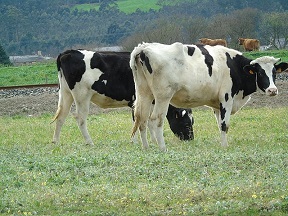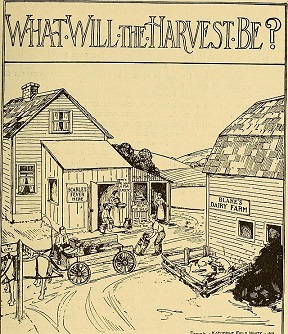In a first article, we looked into the problem of animal welfare and ammonia emissions in modern cow sheds. Where faeces and urine come into contact with each other. Can we solve this manure problem – while maintaining an economically viable sector of animal husbandry? Herman A. de Boer investigated this.
This is the second of two articles on the manure problem. The first one was published on September 29, 2023.

Manure: old-fashioned solutions
The origin of the ammonia emissions is that in ‘modern’ stables we immediately mix urine and faeces. That was different, back in the days when farmers made use of old-fashioned cesspits. These only collected urine. Faeces were removed by wheelbarrows; it could be mounted. In the course of the winter season, this led to high dunghills. From a hygienic point of view, the development of the modern cubicle barn was for the worse. We need to innovate, says De Boer: in order to clean the cows’ behinds, and at the same time prevent mixing of urine and faeces. Preventing that urine and faeces end up on the floors, with the claw problems resulting from it; preventing also cows wading through the dung, resulting in filthy udders.
What should we do? There are cowsheds that fulfil all these requirements. Firstly, the HK system, consisting of a sand stable with a cow toilet. In this system, cow manure will be removed mechanically. The urine sinks through a layer of sand, preventing it to come into contact with the faeces. It is removed through a draining system. Whether built anew or refurbished, these stables fulfil even the requirements if located next to natural areas. They can also be fitted into the landscape. This manure system relies on cows that have learned to make use of a urinal. If this process is started early and is maintained consequently (also at night and if cows are in the meadow), cows appear to learn the trick well and fast.

The robot
Lely’s manure suction robot might be an alternative, applicable in larger farms; it should be completed by a cleaning system for the cow’s behind. In this system, newly produced faeces are being removed by suction, by a robot. The robot immediately cleans the location where the dung has fallen – and therefore, the contamination with a subsequent urine discharge will be minimized. Urine that does fall on the floor, will disappear through narrow cracks.
The two systems can be combined. Which will offer many advantages. Urea can be removed and treated separately. Cow hygiene will improve a lot. Therefore, the farmer will need less antibiotics, for there will be less infections. And remember, says De Boer: clean cows imply a lot for the animals’ wellbeing; in nature, cows never walk through their own dung and urine. In cubicle barns, way too many cows have a dirty behind, or walk with difficulty because of soft and painful hoofs, at times also with stinking paws.
Cost
What will the transformation cost? ‘At any rate,’ says De Boer, ‘the cost of the HR system will be a fraction of what government now appears to be willing to pay to farmers to stop entirely. Farms in the neighbourhood of Natura 2000 areas should be able to apply first for the renovation.’ If the renovation process should be conducted properly and large-scale, the initial costs should be low. And don’t leave out of consideration that farmers will spend much less on fertilizer.
And in fact, there are more benefits to such a scheme. If we apply this process, farmers will separate nitrogen fertilizer (in the urine) from phosphate fertilizer (in the faeces). We would prevent that dairy farmers would have to remove some of their slurry because of limitations to phosphate use; whereas they would have to apply nitrogen fertilizer in order to make up for nitrogen shortages. Also, meadow birds might appreciate such a new regime. They hate slurry, but they might return if the new system would be applied. In short, an innovative dairy farm system with many opportunities.
The effect
But will farmers embrace Herman de Boer’s ideas? Alle Bruggink has second thoughts about this. Because De Boer uses technical terms that modern policy makers don’t understand. Like ‘biochemical reactions’, ‘urease’ – people might think: the professor may be right, but I don’t understand it and I can nowhere verify his ideas. Almost as bad as ‘science is just another opinion’. Just take the word urease. ‘Oh, is it an enzyme? Then we’re talking digestion aren’t we?’ In short, Alle says, science is on its way to lose its position in the world of public administration. And that would be a pity, for Herman de Boer’s ideas have an impact on many areas simultaneously. They are to the benefit of farmers. And of cattle. And of the environment. Would any scheme be better than this one?
Interesting? Then also read:
Towards sustainable meat consumption
Chemistry vs. bacteria, # 71. The future of pharma in 3 acts, no.3. Towards a holistic approach
Food and water as geopolitical assets

Hallo. Ik ben Ali uit Iran. Ik heb goede ideeën voor de moderne landbouw. Ik ben op zoek naar investeerders en wetenschappelijke sponsors. Mijn ID-adres in Telegram::@addamiyat